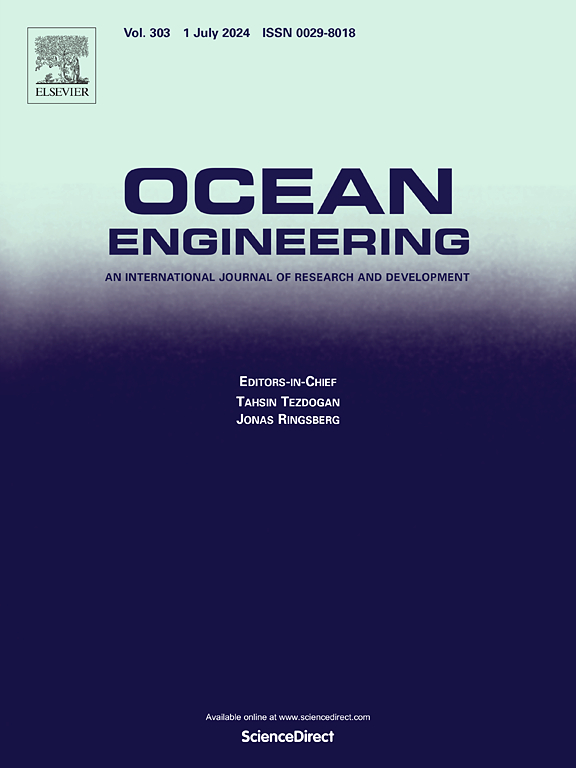几何参数影响下环形螺旋桨流体力学性能的数值研究
IF 4.6
2区 工程技术
Q1 ENGINEERING, CIVIL
引用次数: 0
摘要
高效率、低噪音环形螺旋桨的最新进展引起了人们的极大兴趣,因为它们有可能彻底改变海上推进方式。本研究针对这一空白,利用已建立的环形螺旋桨几何建模方法设计了一种新型变体,并使用雷诺平均纳维-斯托克斯(RANS)方法和剪应力传输(SST)k-ω 湍流模型对其流体力学性能进行了评估。本文首先介绍了环形螺旋桨的概念和建模方法,然后分析了网格大小对数值模拟的影响。然后建立了数值结果与实验数据之间的对应关系,以验证计算模型的准确性。随后,研究探讨了环形螺旋桨的流体力学性能,包括叶片表面的压力分布和螺旋桨尾流在不同推进系数下的流场动力学。随后,研究探讨了轴跨比、横向角、滚动角和垂直角等几何参数对流体动力学性能的影响,阐明了它们对径向截面压力分布剖面、推力系数和开水效率的影响。研究结果为未来环形螺旋桨优化设计中的几何参数选择提供了实质性指导。本文章由计算机程序翻译,如有差异,请以英文原文为准。
Numerical research on hydrodynamic performance of toroidal propeller under the influence of geometric parameters
Recent advancements in high-efficiency, low-noise toroidal propellers have garnered significant interest due to their potential to revolutionize maritime propulsion. This study addresses this gap by leveraging established geometrical modeling methods for toroidal propellers to design a novel variant, and assesses its hydrodynamic performance using the Reynolds-averaged Navier-Stokes (RANS) method coupled with the Shear Stress Transport (SST) k-ω turbulence model. First, the paper introduces the toroidal propeller concept and modeling method before analyzing the impact of grid size on numerical simulations. The correspondence between numerical results and experimental data is then established to validate the computational model's accuracy. Following this, the study explores the hydrodynamic performance of the toroidal propeller, including pressure distribution on the blade surface and the flow field dynamics in the propeller's wake across varying advance coefficients. Subsequently, it examines the influence of geometric parameters such as axis span ratios, lateral angles, roll angles, and vertical angles, on the hydrodynamic performance, elucidating their effects on the pressure distribution profiles at radial sections, thrust coefficient, and open water efficiency. The findings provide substantial guidance for the geometric parameter selection in the optimal design of future toroidal propellers.
求助全文
通过发布文献求助,成功后即可免费获取论文全文。
去求助
来源期刊

Ocean Engineering
工程技术-工程:大洋
CiteScore
7.30
自引率
34.00%
发文量
2379
审稿时长
8.1 months
期刊介绍:
Ocean Engineering provides a medium for the publication of original research and development work in the field of ocean engineering. Ocean Engineering seeks papers in the following topics.
 求助内容:
求助内容: 应助结果提醒方式:
应助结果提醒方式:


